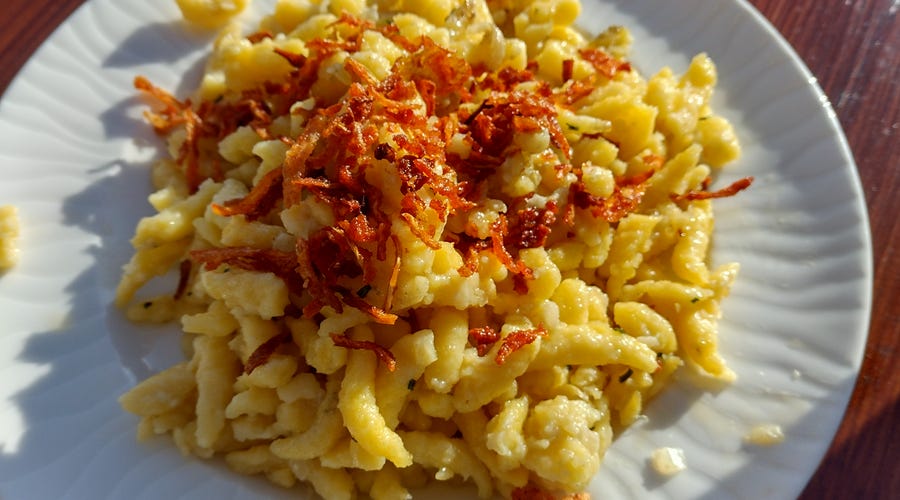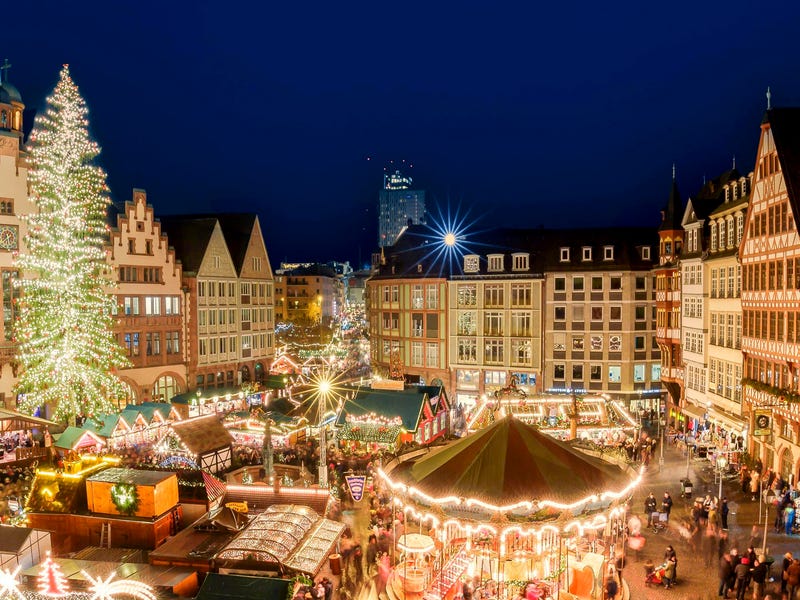
30+ wonderful traditional German & Austrian food dishes to try
Author: Marie Schmoll
Food is to culture what salt is to pretzels: It’s the first thing we notice, the fun stuff, sprinkled on top, but it’s also a crucial part of the dough, giving it taste and texture and ultimately making it what it is.
For centuries, what we ate reflected on our landscape, climate and resources. Today, we can make an order on a delivery app and get any food in the world, so our food choices eventually reflect our preferences.
In Germany, some of these have evolved, as German cuisine gets more diverse and Germans tend to eat a lot more plant-based, but some German foods will hopefully never change because you can never get enough Apfelstrudel, Stollen, kale and Kartoffelsalat!
As a German learner, you’ll see that you can find a special access to a culture by learning about its food.
Table of contents
- A history of German food and culture
- What is Germany’s national dish
- German breads and pastries
- Kohls and Krauts
- Austrian foods
- Swiss foods
- German desserts
- German Christmas treats
- Conclusion
A history of German food and culture
In recent years, Germany has seen a significant shift towards a more plant-based diet as part of a broader global trend towards sustainability and health-consciousness. Traditionally known for their hearty meat dishes like Bratwurst, Schnitzel, and Sauerbraten, Germans are now favoring more and more veggies, legumes, and grains and finding delicious alternatives for animal products.
Another important change is how diverse German foods have become. As immigrants enter the German culinary landscape, foods fuse and new dishes appear, like the famous Döner Kebab that was invented by Turkish immigrants in Berlin. Everybody adds their own ingredients to the melting pot, so to speak.
What is Germany’s national dish
Germany doesn't have one official national dish, but there’s a lot of traditional German food, and a number of different dishes could be considered the national dish.
Sauerbraten
The most common one is probably the “Sauerbraten”, a traditional German pot roast, renowned for its unique marinating process, where the meat, typically beef, is steeped in a mixture of vinegar or wine, water, herbs, spices, and sometimes vegetables for several days.

Bratwurst
Bratwurst is the ultimate German sausage. Its name derives from the Old High German Brätwurst, from brät-, finely chopped meat, and Wurst, or sausage. The Bratwurst is universally celebrated for its savory, robust flavor - a staple at German barbecues and street food stands.
Kartoffelsalat
The delicious German potato salad varies distinctly between regions, with some versions made in a creamy, mayonnaise-based dressing, and others in a lighter, vinegar-based one. This versatile, comforting dish is often served as a side dish at barbecues, picnics, and holiday meals.
Spätzle
Spätzle, a traditional German noodle dish, is made from a simple dough of eggs, flour, and water, serving as a delightful companion to hearty sauces and stews or as a main dish when topped with cheese and fried onions in the Swabian specialty Käsespätzle.
Rouladen
This iconic German food consists of thin slices of beef rolled around a filling of mustard, onions, pickles, and bacon. Slowly braised until tender, it’s a classic example of German comfort food.
Currywurst
The famous Currywurst is a pork sausage cut into slices and seasoned with curry ketchup, popular as street food and often served with fries. Note that a lot of German sausages are now also available as vegetarian and vegan options!
Königsberger Klopse
Named after the former German city of Königsberg, Königsberger Klopse consists of meatballs in a creamy white sauce with capers.
Maultaschen
Potstickers, momos, gyoza or ravioli - everyone has their own version of dumplings, and this is the German german potato dumpling: Literally translating to “mouth pockets”, these are truly nothing but delicious little dough pockets for your mouth, filled with meat or veggies.
Kartoffelpuffer
Kartoffelpuffer or Reibekuchen are German potato pancakes. Similar to French crêpes but slightly thicker, they can be served sweet with jams, or as a savory dish with cheese.
Döner
You can’t go to Berlin, and not eat a Döner! Popularized in Germany by Turkish immigrant communities, it soon became a significant part of German urban food culture. It consists of meat, cooked on a vertical rotisserie, and is served in a flatbread or pita, with veggies.
German breads and pastries
In Germany, bread is an absolute staple. Sometimes we like to eat it twice a day, for breakfast, and for dinner, which we call “Abendbrot”, or literally “evening bread”.
Luckily, with over 300 different types of breads, we never run out of options, from dense, dark Pumpernickel to the grainy Vollkornbrot.
Another thing we love are pastries! Flaky layers of Strudel, and sweet bites of Berliner Pfannkuchen are great choices for “'Kaffee und Kuchen”, that time in the afternoon when Germans traditionally have their coffee and eat something sweet.

Pretzels
The Pretzel, or "Brezel" as we call it, is an icon of German baking craft. This simple, twisted knot of dough, sprinkled with salt, and baked to a golden brown, is a popular snack, often enjoyed with a Maß of beer, especially on Oktoberfest!
Brötchen
Brötchen, the quintessential German bread roll, is cherished for its crispy crust and soft, fluffy interior. These small, round rolls are a morning delight, often served with cold cuts, cheese, or jam, and are a key component of the traditional German "Frühstück" (breakfast).
Schwarzbrot
Schwarzbrot, literally translating to 'black bread', is a dense, hearty rye bread celebrated for its deep, earthy flavor and long shelf life.
Pumpernickel
A dark, dense bread made from coarsely ground rye grain, slowly baked to achieve its characteristic dark color, Pumpernickel is not for everyone but those who like it, usually love it.
Apfelstrudel
Apfelstrudel is a delicate, flaky pastry, filled with spiced apples and cinnamon. Baked to golden perfection, it's traditionally served warm, and dusted with powdered sugar.
Franzbrötchen
This regional specialty pastry from Hamburg resembles a Danish without the pudding, and is especially popular in Northern Germany.
Kohls and Krauts
In German, "Kohl" means “cabbage”, and “Kraut” refers to a broad group of leafy greens and herbs. It’s most famously associated with "Sauerkraut," which is the German word for “fermented cabbage”. Here are some of the main types of Kohls and Krauts. We have it in green, red, and white, so if you need to brush up on your colors first, check out our vivid German color guide!

Sauerkraut
Sauerkraut is made from finely shredded cabbage fermented by lactic acid bacteria. It's known for its distinctive sour flavor and health benefits, often served as a tangy side dish.
Rotkohl
Rotkohl literally translates to “red cabbage”. Slowly cooked with apples, onions, and a mix of spices like cloves and bay leaves, it makes for a sweet and sour delicacy. Thanks to its purple color, it also makes any savory meal it gets served with look extra pretty!
Weißkohl
Weißkohl is white cabbage, a versatile vegetable widely used in German cuisine. It's the key ingredient in making traditional Sauerkraut, but it's also used in a variety of other dishes, including cabbage rolls, soups, and salads.
Grünkohl
Grünkohl - you guessed it - translates to “green cabbage” and it’s actually kale! Traditionally enjoyed in the colder months, it's often slow-cooked with onions, smoked sausages, making it a rich, flavorful winter comfort food, and for many people, especially in the North, it’s the number one Christmas meal!
Kohlrouladen
Kohlrouladen are stuffed cabbage rolls, filled with minced meat, mixed with onions, rice or breadcrumbs, and spices. These rolls are then braised or baked in a savory broth.
Austrian foods
From the bustling cafes of Vienna serving the world-famous Sachertorte, to the rustic taverns in the Alps offering comforting stews and Wiener Schnitzel, Austrian cuisine has a lot to offer!
Keep in mind that some German food words are significantly different in Austrian German.

Tafelspitz
Austria’s national dish, the Tafelspitz is boiled beef, cooked slowly with root vegetables, like horseradish sauce, apple sauce, and creamy spinach.
Wiener Schnitzel
The famous Wiener Schnitzel is a thin cutlet of veal, breaded and fried to a golden crisp, traditionally served with a slice of lemon, and often potato salad or French fries.
Kaiserschmarrn
This culinary gem can be described as a fluffy shredded pancake. Named in honor of Kaiser Franz Joseph I, it’s made from a rich batter, fried in butter, and torn into bite-sized pieces, before it’s served with raisins, almonds, and a dusting of powdered sugar.
Swiss foods
Swiss cuisine is a blend of influences from its German, French, and Italian neighbors, reflecting the country's multicultural heritage. Inspired by the cows of the Alpine pastures, it also has a particular emphasis on dairy products like cheese and chocolate.

Fondue
This Swiss dish involves melting cheese into a communal pot, and dripping pieces of bread in it. Fondue is not just a meal but a social experience, often enjoyed during gatherings and celebrations, and it can be smelled from far away!
Raclette
Raclette is both a type of cheese and a dish centered around the melting of this cheese. At a raclette meal, slices of raclette cheese are melted, and then scraped onto the plate.
Rösti
This simple meal is made from coarsely grated potatoes that are pan-fried until crisp, forming a flat cake. Often enjoyed as a breakfast item or a side dish, Rösti embodies the comfort and heartiness of Alpine cooking.
Swiss Chocolate
Of course, you can’t say “Swiss” without also saying “chocolate”.
Swiss chocolate is renowned worldwide for its superior quality, smooth texture and rich flavor. It owes its excellence to the use of high-quality ingredients and a pioneering chocolate-making process, including the conching method developed by Rodolphe Lindt in the late 19th century.
Learn more about Swiss food and culture here, we love it so much we dedicated an entire article to it.
German desserts
I hope you saved some room for dessert (at least in your vocabulary book)!

Schwarzwälder Kirschtorte
Schwarzwälder Kirschtorte, is a famous German dessert named after the Black Forest, or Schwarzwald. It features layers of rich chocolate sponge, soaked in Kirschwasser (a clear cherry brandy), filled with whipped cream and cherries, and because that’s not enough calories already, it’s typically adorned with more whipped cream, chocolate shavings, and a literal cherry on top.
Bienenstich
Bienenstich, or "Bee Sting Cake," is a classic German dessert featuring a yeast dough layered with creamy custard and topped with a honey-almond glaze.
Donauwelle
Donauwelle means "Danube Wave Cake", named after its striking wavy look. This layered cake combines light and dark sponge cake with cherries, covered with buttercream and a chocolate glaze that creates those wavy patterns, reminiscent of the Danube River's waves.
German Christmas treats
Christmas plays a huge role in German culture. You can learn all about it on our ultimate German Christmas guide - but for now let’s focus on the important things: Christmas treats!

Spekulatius
Spekulatius is a traditional spiced cookie, with a crisp texture and a blend of spices like cinnamon, nutmeg, cloves, and cardamom. The best part is that they feature intricate designs of cute little figures and buildings.
Lebkuchen
Lebkuchen is the German version of gingerbread. These soft, spiced treats come in many shapes and sizes, but most often as pretzels, stars and hearts.
Marzipan
Marzipan, made of almonds and sugar, is often shaped into fruits, figures, or used as a layer in cakes and pastries. You’ll also often find marzipan shaped like lucky symbols including clovers, horseshoes and piggies!
Gebrannte Mandeln
Gebrannte Mandeln are "burnt” or roasted almonds. You can find them at all Christmas markets and fairs, where they lure in passersby with their warm, sweet scent.
Stollen
It acts like it’s bread but it’s definitely dessert, and one of my favorite ones, too!
Stollen is a dense, bread-like fruitcake, generously dotted with raisins, nuts, spices, and a marzipan core.
Dusted with a snowy layer of powdered sugar, it always reminds me of a beautiful German Christmastime landscape which makes it the ultimate Christmas treat.
Guten Appetit
If you’re now ready to take your taste buds on an adventure through Germany's history and heritage, you should book your trip to Germany and order some of those delicious treats for yourself. Make sure you check out our guide on ordering foods in German and keep our extra helpful German blog handy at all times!


